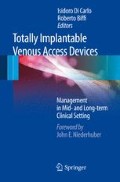Abstract
Correct location of the central catheter extremity attached to totally implantable ports is mandatory in order to avoid complications and to maintain functionality. But there is still a debate about the definition of the optimal position. Obviously, sites such as the very cranial segment of the vena cava superior or the caudal part of the right atrium are to be avoided. The golden middle-way is located between these extreme locations, at the junction between the lower portion of the superior vena cava and the upper right atrium. However, even if a consensus can be reached regarding this peculiar site, description of correlations between anatomical boundaries of veins and visible radiological landmarks varies in function of the chosen imaging method. This chapter will address the issues of correct catheter tip position with regard to complications and performance and provide some insight about correlations between various venous segments and surrounding bony structures.
Access this chapter
Tax calculation will be finalised at checkout
Purchases are for personal use only
References
Vesely TM (2003) Central Venous Catheter Tip Position: A Continuing Controversy. J Vasc Interv Radiol 14:527–534
Nakazawa N (2010) Challenges in the Accurate Identification of the Ideal Catheter Tip Location. JAVA 15:196–200
Schutz JCL, Patel AA, Clark TWI et al (2004) Relationship between Chest Port Catheter Tip Position and Port Malfunction after Interventional Radiologic Placement. J Vasc Interv Radiol 15:581–587
Cadman A, Lawrance JA, Fitzsimmons L et al (2004) To clot or not to clot? That is the question in central venous catheters. Clin Radiol 59:349–355
Caers J, Fontaine C, Vinh-Hung V et al (2005) Catheter tip position as a risk factor for thrombosis associated with the use of subcutaneous infusion ports. Support Care Cancer 13:325–331
Korones DN, Buzzard CJ, Asselin BL, Harris JP (1996) Right atrial thrombi in children with cancer and indwelling catheters. J Pediatr 128:841–846
Kearns PJ, Coleman S, Wehner JH (1996) Complications of long-arm-catheters: A randomized trial of central vs peripheral tip location. JPEN 20:20–24
Pittiruti M, Hamilton H, Biffi R et al (2009) ESPEN guidelines on parenteral nutrition: central venous catheters (access, care, diagnosis and therapy of complications) Clinical Nutrition 28:365–377
Food and Drug Administration Task Force (1989) Precautions necessary with central venous catheters. FDA Drug Bulletin 15–16
National Association of Vascular Access Networks (1998) NAVAN Position Statement. J Vasc Access Devices 3:8–10
McGee WT, Ackerman BL, Rouben LR et al (1993) Accurate placement of central venous catheters: A prospective randomized, multicenter trial. Crit Care Med 21:1118–1123
Barnacle A, Arthurs O, Roebuck D, Hiorns M (2008) Malfunctioning central venous catheters in children: a diagnostic approach. Pediatr Radiol 38:363–378
Goossens GA, Stas M, Moons P (2011) Management of functional complications of totally implantable venous access devices by an advanced practice nursing team: 5 years of clinical experience, submitted
Xiang DZ, Verbeken EK, Van Lommel ATL, Stas M, De Wever I (1998) Composition and formation of the sleeve enveloping a central venous catheter. J Vasc Surg 28:260–271
National Kidney Foundation (2001) K/DOQI Clinical Practice Guidelines for Vascular Access. Am J Kidney Dis 37(Suppl 1):S137–S181
Chu K-S, Hsu J-H, Wang S-S et al (2004) Accurate central venous Port-A-Catheter placement: Intravenous electrocardiography and surface landmark techniques compared by using transesophageal echocardiography. Aesth Analg 98:910–914
Fricke BL, Racadio JM, Duckworth T et al (2005) Placement of peripherally inserted central catheters without fluoroscopy in children: Initial catheter tip position. Radiology 234:887–892
Ku YH, Kuo PH, Tsai YF et al (2009) Port-A-Cath implantation using percutaneous puncture without guidance. Ann Surg Oncol 16:729–734
Peres PW (1990) Positioning central venous catheters-a prospective study. Aneasth Intens Care 8:536–539
Greenall MJ, Blewitt RW, McMahon MJ (1975) Cardiac tamponade and central venous catheters. BMJ 2:595–597
Aslamy Z, Dewald CL, Heffner JE (1998) MRI of central venous anatomy. Implications for central venous catheter insertion. Chest 114:820–826
Baskin KM, Jimenez RM, Cahill AM et al (2008) Cavoatrial junction and central venous anatomy: Implications for central venous access tip position. J Vasc Interv Radiol 19:359–365
Storm ES, Miller DL, Hoover LJ et al (2006) Radiation Doses from Venous Access Procedures. Radiology 238:1044–1050
Marcy PY, Magné N, Castadot P et al (2007) Is radiologic placement of an arm port mandatory in oncology patients?: an analysis of a large bi-institutional experience. Cancer 110:2331–2338
Radke J, Lange LP, Bartels A, Brunsch C (1990) Control of the placement of a central venous catheter using Doppler ultrasound. Aneasthesist 39:283–287
Schummer W, Schummer C, Schelenz C et al (2004) Central venous catheters-the inability of ‘intra-atrial ECG’ to prove adequate positioning. Br J Anaesth 93:193–198
Popp MB, Dobrilovic N, Matern W et al (2005) Accuracy of implanted port placement with the use of the electromagnetic CathTrack ® catheter locator system. The Journal of Vascular Access 6:9–12
Author information
Authors and Affiliations
Editor information
Editors and Affiliations
Rights and permissions
Copyright information
© 2012 Springer-Verlag Italia
About this chapter
Cite this chapter
Stas, M., Coolen, J. (2012). Optimal Catheter Tip Position: Radiologic Criteria and Clinical Relevance. In: Di Carlo, I., Biffi, R. (eds) Totally Implantable Venous Access Devices. Springer, Milano. https://doi.org/10.1007/978-88-470-2373-4_9
Download citation
DOI: https://doi.org/10.1007/978-88-470-2373-4_9
Publisher Name: Springer, Milano
Print ISBN: 978-88-470-2372-7
Online ISBN: 978-88-470-2373-4
eBook Packages: MedicineMedicine (R0)

